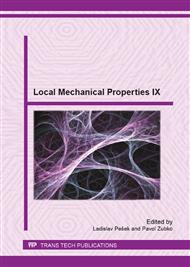[1]
JR Davis Davis &associated, Heat Resistant Materials, ASM Specjality Handbook, ASM Inter. (1997).
Google Scholar
[2]
M. Garbiak, W. Jasiński, B. Piekarski, Materials for Reformer Tubes. History of Evolution, Archives of Foundary Engineering 2 (2011) 47-52.
Google Scholar
[3]
L. Shinoda et al., The Effect of Single and Combined Additions of Ti and Nb on the Structure and Strength of the Centrifugally Cast HK40 Steel, Trans. ISIJ 18 (1978) 139-148.
DOI: 10.2355/isijinternational1966.18.139
Google Scholar
[4]
H. Wen-Tai, R.W.K. Honeycombe, Structure of Centrifugally Cast Austenitic Stainless Steel, Part 2: Efects of Nb, Ti and Zr, Mater. Sc. Technol. 1 (1985) 390-394.
DOI: 10.1179/mst.1985.1.5.390
Google Scholar
[5]
R.M. Wang, Y.G. Song, Y.F. Han, Effect of Rare Earth on the Microstructures and Properties of a Low Expansion Superalloy, Journal of Alloys and Compounds 311 (2000) 60-64.
DOI: 10.1016/s0925-8388(00)00862-8
Google Scholar
[6]
Y. Watanabe, V. Kain, T. Tonozuka, T. Shoji, T. Kondo, F. Masuyama, Effect of Ce Addition on the Sensitization Properties of Stainless Steels, Scripta Materialia 42 (2000) 307-312.
DOI: 10.1016/s1359-6462(99)00352-8
Google Scholar
[7]
F. Hanguang, X. Qiang, L. Yanxiang: A Study of the Microstructures and Properties of Fe-V-W-Mo Alloy Modified by Rare Earth, Materials Science and Engineering A395 (2005) 281-287.
Google Scholar
[8]
H. Ha, Ch. Park, H. Kwon, Effects of Misch Metal on the Formation of Non-metallic Inclusions and the Associated Resistance to Pitting Corrosion in 25% Cr Duplex Stainless Steels, Scripta Materialia 55 (2006) 991-994.
DOI: 10.1016/j.scriptamat.2006.08.014
Google Scholar
[9]
J. Lu, Q. Xue, Comparison on the Microstructure and Mechanical Strength of a Ni-based Alloy with and without 3wt. % CeF3 Addition, Materials Science and Engineering A257 (1998) 268-272.
DOI: 10.1016/s0921-5093(98)00850-8
Google Scholar
[10]
G.C. Wu, Q. You, D. Wang, Influence of the Addition of Lanthanum on a W-Mo-Ni-Fe Heavy Alloy, International Journal of Refractory Metals &Hard Materials 17 (1999) 299-304.
DOI: 10.1016/s0263-4368(99)00015-3
Google Scholar
[11]
Z. Bojarski, E. Łągiewka, X-ray phase analysis, PWN, Warszawa, (1995).
Google Scholar
[12]
M. Garbiak, R. Chylińska, Microhardness of Phase Constituents Present in Crepp-resistant cast Steel, Chem. Listy 105 (2011) 187-190.
Google Scholar
[13]
D.A. Lucca, K. Hermann, M. J. Klopfstein, Manuf. Techn. 59 (2010) 803-819.
Google Scholar


